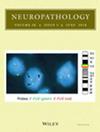A case of trigeminal malignant melanotic nerve sheath tumor in the wide spectrum of melanotic and nerve sheath tumors.
IF 1.3
4区 医学
Q4 CLINICAL NEUROLOGY
引用次数: 0
Abstract
Sir, Nerve sheath tumors are heterogeneous and common nervous system tumors that can arise sporadically or in the context of several tumor predisposing syndromes. They can range from benign forms to malignant ones. On the other hand, primary melanotic nervous system tumors, or secondary ones, such as melanoma metastasis, are much less common. Malignant melanotic nerve sheath tumors (MMNSTs), formerly known as melanotic schwannomas, are rare tumors that can belong to both these groups. The rename was proposed in the most recent World Health Organization classification, considering its recently acknowledged highly aggressive profile. We report the case of a 42-year-old male, without any other personal or familiar relevant background, who was referred to a neurosurgery outpatient clinic due to a yearlong altered right facial sensitivity with paresthesia. Facial hypoesthesia in V1 and V2 divisions of the right trigeminal nerve was noticed. No other deficits were evidenced, and the remaining objective examination was unremarkable, namely for cutaneous lesions. Brain magnetic resonance imaging (MRI) displayed a space-occupying lesion in the right cavernous sinus, suggestive of a melanin-rich lesion. Three months later, the patient reported right facial hypoesthesia extending to V3, along with chewing difficulties lateralized to the right. A new MRI showed lesion growth toward Meckel’s cavum and the path of the right trigeminal nerve (Fig. 1), and the patient was referred to neurosurgery. Using a subtemporal, extradural approach, a lesion with black coloration that was confined to Meckel’s cavum between trigeminal fascicles was nearly completely removed (Fig. 1). The posterior fossa extent was also removed after all of the Meckel’s cavum portion was decompressed. Neuropathological examination revealed a fasciculate tumor with mixed epithelioid and spindled cells, with great nuclear polymorphism and atypia, however without necrosis, mitotic activity, or psammoma bodies. These elements were immunoreactive for vimentin, S100, SOX10, HMB45, and Melan-A, the latter two with a heterogeneous distribution (Fig. 2). A genetic analysis for the BRAF V600E mutation was negative. A diagnosis of MMNST was proposed, and the patient was further referred for stereotaxic radiotherapy (54 Gy in 30 fractions). MMNSTs are rare, pigmented, slowly growing neoplasms that account for less than 1% of all nerve sheath tumors. These tumors typically develop at an early age, with no sex predilection, and are most likely to be found in the spinal nerves and paraspinal ganglia, and rarely at an intracranial level. Histologically, they present with melanin-producing neoplastic Schwann cells, likely due to a shared neural crest cell background, and they can be divided into psammomatous and non-psammomatous forms. The psammomatous type has long been associated with the Carney complex, which also includes the presence of pigmented cutaneous lesions, cardiac myxoma, and endocrine tumors. Suggestive family history was excluded in this patient. Though uncommon, MMNSTs should differentiated from other nerve sheath tumors and melanotic tumors since they carry important therapeutic and prognostic implications. Besides the fact the tumor was dark, the distinction between a classic schwannoma and a MMNST was further reinforced by MRI, given that, although both lesions were contrast-enhancing, MMNST is commonly hypointense in T2 sequences and spontaneously hyperintense in T1 sequences without contrast, as in our case (Fig. 1), due to the paramagnetic properties of melanin. Establishing this distinction is relevant because, although both tumors were previously considered benign, MMNSTs appear to have a more malignant course than once thought, with the potential to metastasize and having high recurrence rates. This aggressive course motivated its aforementioned recent rename. The prognosis can be worse when presenting in the context of familiar syndromes, such as the Carney complex or neurofibromatosis type II. Notably, cutaneous stigma and familiar history that would be Correspondence: Augusto Rachão, Neurology Department, Hospital Garcia de Orta, Av. Torrado da Silva, 2805-267 Almada, Portugal. Email: augusto.rachao@hgo.min-saude.pt三叉神经恶性黑质神经鞘肿瘤1例在黑质和神经鞘肿瘤的广谱。
本文章由计算机程序翻译,如有差异,请以英文原文为准。
求助全文
约1分钟内获得全文
求助全文
来源期刊

Neuropathology
医学-病理学
CiteScore
4.10
自引率
4.30%
发文量
105
审稿时长
6-12 weeks
期刊介绍:
Neuropathology is an international journal sponsored by the Japanese Society of Neuropathology and publishes peer-reviewed original papers dealing with all aspects of human and experimental neuropathology and related fields of research. The Journal aims to promote the international exchange of results and encourages authors from all countries to submit papers in the following categories: Original Articles, Case Reports, Short Communications, Occasional Reviews, Editorials and Letters to the Editor. All articles are peer-reviewed by at least two researchers expert in the field of the submitted paper.
 求助内容:
求助内容: 应助结果提醒方式:
应助结果提醒方式:


